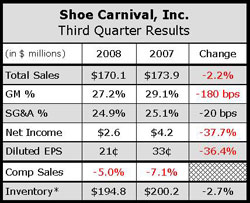With store traffic slowing significantly after the back-to-school selling period, Shoe Carnival reported Q3 earnings fell 38.1% as net sales slid 2.2% and comps dropped 5% for the quarter. On a conference call with analysts, SCVL President and CEO Mark Lemond said comps had been improving during BTS until Labor Day weekend, when “we saw our slightly positive comps quickly taper off as our targeted moderate income consumer ceased being motivated by need and retail spending became more discretionary.

This ongoing trend of changing consumer behavior has created an increasingly difficult retail climate.”
The sales declines reflects a continued decline in customer traffic as average unit retails, average transactions, and units per transactions were all up due to a push to raise prices. All departments saw negative comps except for children's, which was flat in the quarter.
Sales gains in athletic during BTS were driven by Chucks, Nike, and most of the traditional performance athletic brands such as Asics and Saucony. In children's, BTS sales were also driven by athletics. As noted in its Q208 conference calls, the BTS increases seen in adult athletics were driven primarily by higher average unit retails.
“These higher unit retails were basically a result of our strategy to buy more performance product and performance brands which command these higher retails,” said Cliff Sifford, EVP and general merchandise manager. “Our children's increase was a result of both increasing pair sales and higher average unit retails.”
Sifford also noted that both women's' and children's boot assortment were up high-single-digits on a comparable store basis in Q3.
“I point to these two examples of back-to-school and boot sales to show that even though we are going through a tough economic downturn, our customer looks to us to offer a great selection of trend right product for the entire family at key time periods,” said Sifford. “We will continue to better serve our customer by buying depth in the key items and trends of the season, while continuing to reduce our overall assortments.”
The 190 basis point gross margin decline reflected a 110 basis point decline in merchandise margins and an 80 basis point decline in occupancy costs. The lower merchandise margins were driven primarily due to slow sales in the women's non-athletic business and aggressive inventory controls. Women's inventory ended the quarter down close to 9% on a per door basis. Overall inventories ended the quarter down 8% on a per door basis.
The $1.2 million decline in SG&A expenses was primarily achieved through a reduction in costs in advertising and employee incentive programs.
Going forward, Shoe Carnival plans to continue to focus on inventory controls while buying in greater depth on key items. It also plans on increasing footwear prices, controlling expenses and maintaining a healthy balance sheet. Shoe Carnival noted that it is reducing its growth rate for 2009 to 15 to 20 new stores.
Lemond noted that increasing prices may prove to be more difficult in the fourth quarter with the retail environment expected to become increasingly promotional and price-sensitive during the holiday season.
“We will react to the pricing and promotional cadence of our competitors in the footwear marketplace,” said Lemond. “We fully expect to continue to lower inventory levels especially with respect to seasonal product. Our current plan is for year-end per store inventories to be about 10% lower than the prior year.”














